Use of Mobile Photothermic Installation on Application of Drip Irrigation Technology in Orchards of Mountain and Foothill Areas of Uzbekistan
Abstract
:1. Introduction
2. Materials and Methods
General Scheme of the Complex Drip Irrigation System
3. Results and Discussion
3.1. Drip Irrigation System
Efficiency of Drip Irrigation System
3.2. Solar Energy Installation System with Pumping Units
3.3. Irrigation Automation System
3.4. Supply of Quality Water to the Drip Irrigation System
4. Conclusions
- 1.
- The use of a mobile PTB system with capacity N = 4.0 kW (8 PTBs with a capacity of 500 W each) allows us to provide energy for pumping units with capacity up to N = 3.0 kW, supplying sufficient water for drip irrigation of 8-10 ha of orchards with fruit trees.
- 2.
- During the summer months, the implementation of photothermal battery (PTB) technology is projected to yield nearly double the electricity generation compared to conventional photovoltaic (PV) systems. This enhanced performance is attributed to the cooling effect inherent in PTBs.
- 3.
- The adaptability of the photothermal battery system enables its utilization across all seasons. The installed capacity utilization factor increases by 30–40% (depending on the location of the research object) compared to stationary systems.
- 4.
- For reliable operation of the drip irrigation system, the supplied water must be purified of sediment up to 0.1 mm. Purification of water supplied to the drip irrigation system from sediment (d > 0.1 mm) by hydraulic method (by improving the design of supply channels and drainage) will allow to operate the system without coarse filters, the use of which leads to additional hydraulic (and, consequently, energy) losses in the system.
- 5.
- Water saving in orchards under the use of complex drip irrigation system at facilities is 67.4% (Republic of Karakalpakstan)—76.1% (Bukhara region) in comparison with traditional irrigation (for the Republic as a whole—60–70%);
Author Contributions
Funding
Data Availability Statement
Acknowledgments
Conflicts of Interest
References
- Grant, F.; Sheline, C.; Sokol, J.; Amrose, S.; Brownell, E.; Nangia, V.; Amos, G.; Winter, V. Creating a Solar-Powered Drip Irrigation Optimal Performance Model (SDrOP) to Lower the Cost of Drip Irrigation Systems for Smallholder Farmers. Appl. Energy 2022, 323, 119563. [Google Scholar] [CrossRef]
- Pawlak, K.; Kołodziejczak, M. The Role of Agriculture in Ensuring Food Security in Developing Countries: Considerations in the Context of the Problem of Sustainable Food Production. Sustainability 2020, 12, 5488. [Google Scholar] [CrossRef]
- Tursunov, B.O.; Uktamov, K.F.; Tukhtamuratova, A. Ways to Ensure Food Security in the Development of a Digital Economy. In Proceedings of the 6th International Conference on Future Networks & Distributed Systems (ICFNDS’22), Tashkent, Uzbekistan, 15 December 2022. [Google Scholar] [CrossRef]
- Decree of the President of the Republic of Uzbekistan, dated 16.01.2018 No. DP-5303, On Measures to Further Ensure the Country’s Food Security. 2018. Available online: https://lex.uz/docs/3506753# (accessed on 17 January 2018).
- Decree of the President of the Republic of Uzbekistan, Dated 10 July 2020 No. 6024, “On Approval of the Concept of Development of the Water Sector of the Republic of Uzbekistan for 2020–2030 Years”. 2020. Available online: https://lex.uz/ru/docs/4892946 (accessed on 11 July 2020).
- Law of the Republic of Uzbekistan No.837-XII of 06.05.1993, “On Water and Water Using”. Available online: https://lex.uz/docs/-12328 (accessed on 12 June 1993).
- Majidov, T.S. Culture of Water Resources Use and Environmental Protection. Monograph; NRU “TIIAME”: Tashkent, Uzbekistan, 2021; 266p. [Google Scholar]
- Suyunov, S. Uzbekistan is a pioneer in Central Asia in the field of water conservation. Agric. Water Manag. Uzb. 2023, 3, 15–16. [Google Scholar]
- Shtepa, B.G.; Nosenko, V.F.; Vinnikova, N.V.; Danilchenko, N.V.; Ostapov, I.S.; Fomin, G.E.; Afanasyev, V.A. Mechanization of irrigation. In Reference Book; Agropromizdat: Moscow, Russia, 1990; 336p. (In Russian) [Google Scholar]
- Sergeeva, T.V. Improving the Technology of Irrigation by Furrows with the Development of an Anti-Erosion System. Ph.D. Thesis, Volgograd State Agricultural Academy, Volgograd, Russia, 2009; p. 27. [Google Scholar]
- Kim, I.A. Development and Research of Automated Systems for Irrigation of Agricultural Crops by Furrows and Sprinkling (Based on the Example of Irrigation Systems of the Chui Valley). Bachelor’s Thesis, Kyrgyz Agricultural Institute, Bishkek, Kyrgyzstan, 1992; p. 30. [Google Scholar]
- Grigorov, S.M. Scientific Foundations of Resource-Saving Technologies of Sprinkling Irrigation of Agricultural Crops in the Lower Volga Region. Ph.D. Thesis, Novocherkassk State Amelioration Academy, Volgograd, Russia, 2009; p. 338. [Google Scholar]
- Turgunov, M.; Koriev, M.; Khusanov, A. A unique method of underground drip irrigation in gardens and its advantages. Sci. Pract. J. Res. Innov. Tashkent 2023, 3, 8–12. [Google Scholar]
- Uspenskaya, M.V. Acrylic Hydrogels as Polymer Binders. Specialty-05.17.06—Technology and Processing of Polymers and Composites. Ph.D. Thesis, St. Petersburg State Technological Institute (Technical University), St. Petersburg, Russia, 2008; p. 318. [Google Scholar]
- Danilova, T.N. Application of Water-Absorbing Polymers to Increase the Water-Holding Capacity of Soils and Water Supply of Agricultural Crops. Ph.D. Thesis, Federal State Budgetary Scientific Institution “Agrophysical Research Institute”, St. Petersburg, Russia, 2023; p. 50. [Google Scholar]
- Pankratov, V.A. Improving Rice Check Planning Technologies Using Earthmoving and Planning Machines with Laser Control Systems. Ph.D. Thesis, Moscow State Institute of Environmental Engineering, Moscow, Russia, 2005; p. 141. [Google Scholar]
- Efremov, A.N. Laser Leveling of Irrigated Lands; LLC (Limited Liability Company) “Liter-Print”: Moscow, Russia, 2016; p. 51. (In Russian) [Google Scholar]
- Ibragimov, N.; Ruzimov, J.; Egamberdiev, O.; Akramkhanov, A.; Rudenko, I.; Nurmetov, K. Dissemination of Resource-Saving Technologies for Sustainable Development of Agriculture in the Khorezm Region of Uzbekistan. Technical Instructions for Land Planning Using a Laser Level; Urganch, Uzbekistan. 2012, p. 24. Available online: https://sgp.uz/userfiles/Lazer%20rus%20low%20resolution.pdf (accessed on 17 January 2018).
- Tursunov, M.N.; Sabirov, H.; Eshmatov, M.M.; Holov, U.R. Substantiating the technical and economic indicators of photothermal and photoelectric mobile devices for water extraction. International Scientific Conference “Tendencies of development of condensed matter physics”, Fergana, Uzbekistan, 30–31 October 2023; pp. 315–319. [Google Scholar]
- Use of Portable Polyethylene Trays (PPL-50) of Semicircular Cross-Section for Irrigation of Agricultural Crops. Available online: http://cawater-info.net/best-practices/en/base/marker/246. (accessed on 4 May 2018).
- Turapin, S.S. Rationalization of Mobile Irrigation Kits for Small-Contour Irrigation Areas. Ph.D. Thesis, Novocherkassk State Melioration Academy, Novocherkassk, Russia, 2007; p. 25. [Google Scholar]
- Decision PQ-144 of the President of the Republic of Uzbekistan Dated 1 March 2022 “On Measures to Further Improve the Introduction of Water-Saving Technologies in Agriculture”. Available online: https://lex.uz/ru/docs/-5884584?ONDATE=21.06.2023# (accessed on 2 March 2022).
- Apalkov, A.; Apalkov, S.; Kuren, S.; Popov, S.; Marchenko, J. Development of a furrow irrigation method. E3S Web Conf. 2020, 210, 04009. [Google Scholar] [CrossRef]
- Majidov, T.S. Study and Implementation of Obtaining High Yields from Oilseeds Using Low-Pressure Drip Irrigation; TIIM Scientific and Technical Report of the Grant AA-7-106-I; TIIM: Tashkent, Uzbekistan, 2011; 72p. [Google Scholar]
- Tursunov, M.N.; Sabirov, K.; Kholov, U.R.; Eshmatov, M. Study of the parameters of a photo-thermal battery in extreme natural conditions. Sol. Eng. 2021, 57, 354–361. [Google Scholar]
- Muminov, R.A.; Tursunov, M.N.; Sabirov, H.; Akhtamov, T.Z.; Eshmatov, M.M. Comprehensive Increase in the Efficiency of a Mobile Photovoltaic Installation for Water Lifting Through the Use of Photothermal Batteries, Side Reflectors of Solar Radiation and Cooling Water from Deep Underground Aquifers. Solar Eng. Eng. 2022, 58, 238–243. [Google Scholar] [CrossRef]
- Rashid, F.L.; Eleiwi, M.A.; Mohammed, H.I.; Ameen, A.; Ahmad, S. A Review of Using Solar Energy for Cooling Systems: Applications, Challenges, and Effects. Energies 2023, 16, 8075. [Google Scholar] [CrossRef]
- Ukoba, K.; Yoro, K.O.; Eterigho-Ikelegbe, O.; Ibegbulam, C.; Jen, T.C. Adaptation of solar energy in the Global South: Prospects, challenges and opportunities. Heliyon 2024, 10, e28009. [Google Scholar] [CrossRef] [PubMed]
- Bardi, U.; El-Asmar, T.; Lavacchi, A. Turning Electricity into Food: The Role of Renewable Energy in the Future of Agriculture. J. Clean. Prod. 2013, 53, 224–231. [Google Scholar] [CrossRef]
- Beckman, J.; Xiarchos, I.M. Why are Californian Farmers Adopting More (And Larger) Renewable Energy Operations? Renew. Energy 2013, 55, 322–330. [Google Scholar] [CrossRef]
- Salvador, R.; Martínez-Cob, A.; Cavero, J.; Playán, E. Seasonal on Farm Irrigation Performance in the Ebro Basin (Spain): Crops and Irrigation Systems. Agric Water Manag. 2011, 98, 577–587. [Google Scholar] [CrossRef]
- Kumar, C.M.S.; Singh, S.; Gupta, M.K.; Nimdeo, Y.M.; Raushan, R.; Deorankar, A.V.; Kumar, T.M.A.; Rout, P.K.; Chanotiya, C.S.; Pakhale, V.D.; et al. Solar Energy: A Promising Renewable Source for Meeting Energy Demand in Indian Agriculture Applications. Sustain. Energy Technol. Assess. 2023, 55, 102905. [Google Scholar] [CrossRef]
- Tursunova, M.N.; Bainov, D.; Dyskin, V.; Krivobokov, V.P.; Sobirov, H. Study of the efficiency of using autonomous photovoltaic stations in hot climates. Academy of Sciences of the Republic of Uzbekistan, Institute of Physics and Technology, RPA “Physics-Sun”. In Proceedings of the International Conference, Tashkent, Uzbekistan, 22–23 September 2020; pp. 25–29. [Google Scholar]
- Turdiev, A.U. Smart Drip Irrigation System. Mini Grant No. UZ-2020-C-005-02, EU, Branch of REC Central Asia in Uzbekistan, PU “Suvchi”; TIIAME: Tashkent, Uzbekistan, 2020. [Google Scholar]
- Serikbaev, B.S.; Sherov, A.G.; Shaimanov, N.O.; Gadaev, N.N. Operation and Automation of Irrigation Networks. Training Manual; TIIAME: Tashkent, Uzbekistan, 2021; 145p. [Google Scholar]
- Hikmatullaev, A.A. Investigation of Abrasive Wear of Pumps in Operation in Water Industry (as an Example of Laboratory Research). Ph.D. Thesis, TIIAME, Tashkent, Uzbekistan, 2018; 59p. [Google Scholar]
- Rakhimbaev, F.M. Practical Classes on Agricultural Hydraulic Reclamation; Mexnat: Tashkent, Uzbekistan, 1991; p. 392. Available online: https://f.eruditor.link/file/1983604/ (accessed on 15 November 2024).
- Saraxatunova, Y.Y. Requirements of drip irrigation systems to irrigation water. Ways to improve efficiency irrigated farming. Sci.-Pract. J. 2021, 3, 22–27. [Google Scholar]
- Bespalov, N.F. Hydromodular Zoning and Irrigation Regime for Agricultural Crops in the Namangan Region. Developed and publisher by RPA “SoyuzKhlopok (Cotton Union)”; SoyuzKhlopok (Cotton Union): Tashkent, Uzbekistan, 1986; p. 36. [Google Scholar]
- Berdiev, M. The effect of turbidity on the flow resistance of streams moving in the form of furrows. In A Collection of Articles of the Traditional XXII Scientific-Practical Conference of Young Scientists, Graduate Students and Talented Students on the Topic “Modern Problems of Agriculture and Water Management”; NRU “TIIAME”: Tashkent, Uzbekistan, 2023; Volume 1, pp. 760–775. [Google Scholar]
- Majidov, T.; Tursunov, M.; Buvabekov, B.; Berdiev, M.; Ergashev, S. Comprehensive Automated Drip Irrigation System. In Proceedings of the Annual International Conference «Construction Mechanics, Hydraulics and Water Resources Engineering» (CONMECHYDRO-2023), Tashkent, Uzbekistan, 26–28 April 2023; Volume 401, p. 01025. [Google Scholar] [CrossRef]
- Buvabekov, B.; Ergashev, S. Automated Drip Irrigation System. In A Collection of Articles of the Traditional XXII Scientific-Practical Conference of Young Scientists, Graduate Students and Talented Students on the Topic “Modern Problems of Agriculture and Water Management”; NRU “TIIAME”: Tashkent, Uzbekistan, 2023; Volume 1, pp. 406–411. [Google Scholar]
- Faizullaev, D.F.; Jurabekov, S.; Abidov, S.; Ubaidullaev, P.; Teshabaev, Z. Determination of Moisture Movement in Soil by Centrifugal Modeling Method; No. 14; Institute of Mechanics, Publishing House “Fan” of the Acadademy of Sciences of the Republic of Uzbekistan: Tashkent, Uzbekistan, 1974. [Google Scholar]
- Tursunov, M.N.; Yuldoshev, I.A. Autonomous photovoltaic system of lifting water from wells. Ecological Bulletin. Clean Energy Sustain. Dev. 2011, 4–5, 52–54. [Google Scholar]
- Eshchanov, O.I. Analiz i Osenka Kachestva Vodi Reki Amudarya. Sci. Notes SIC ICWC 2021, 12, 59. [Google Scholar]
- Isaev, S.; Sarimsakov, M.; Sarimsakova, M.; Turdaliev, A.; Abdukhakimova, K.; Mirzaeva, M. Application of water-saving irrigation technologies of intensive apple orchards in the irrigated regions of Uzbekistan. E3S Web Conf. 2023, 389, 03052. [Google Scholar] [CrossRef]
- Arifjanov, А.; Babajanov, F.; Xoshimov, S.; Sultonov, R. Distribution of River Flow in the River Bed. BIO Web Conf. 2024, 105, 05015. [Google Scholar] [CrossRef]
- Arifjanov, А.; Samiyev, L.; Babajanov, F.; Tadjiboyev, S.; Akramov, J. Assessment of the Productivity of River Sediments. E3S Web Conf. 2024, 538, 03010. [Google Scholar] [CrossRef]
- Otaev, A.A.; Gapparov, S.M.; Karshiev, R.J.; Urazkeldiev, A.B.; Kamilov, B.S.; Ziyatov, M.P. Recommendations for the Dimensions of the Water Softener Pond in the Drip Irrigation System, the Irrigation Tapes to be Used and the Optimal Lengths; Ministry of Water Resources, Research Institute of Irrigation and Water Problems: Tashkent, Uzbekistan, 2022; NRU TIIAME; p. 28. [Google Scholar]
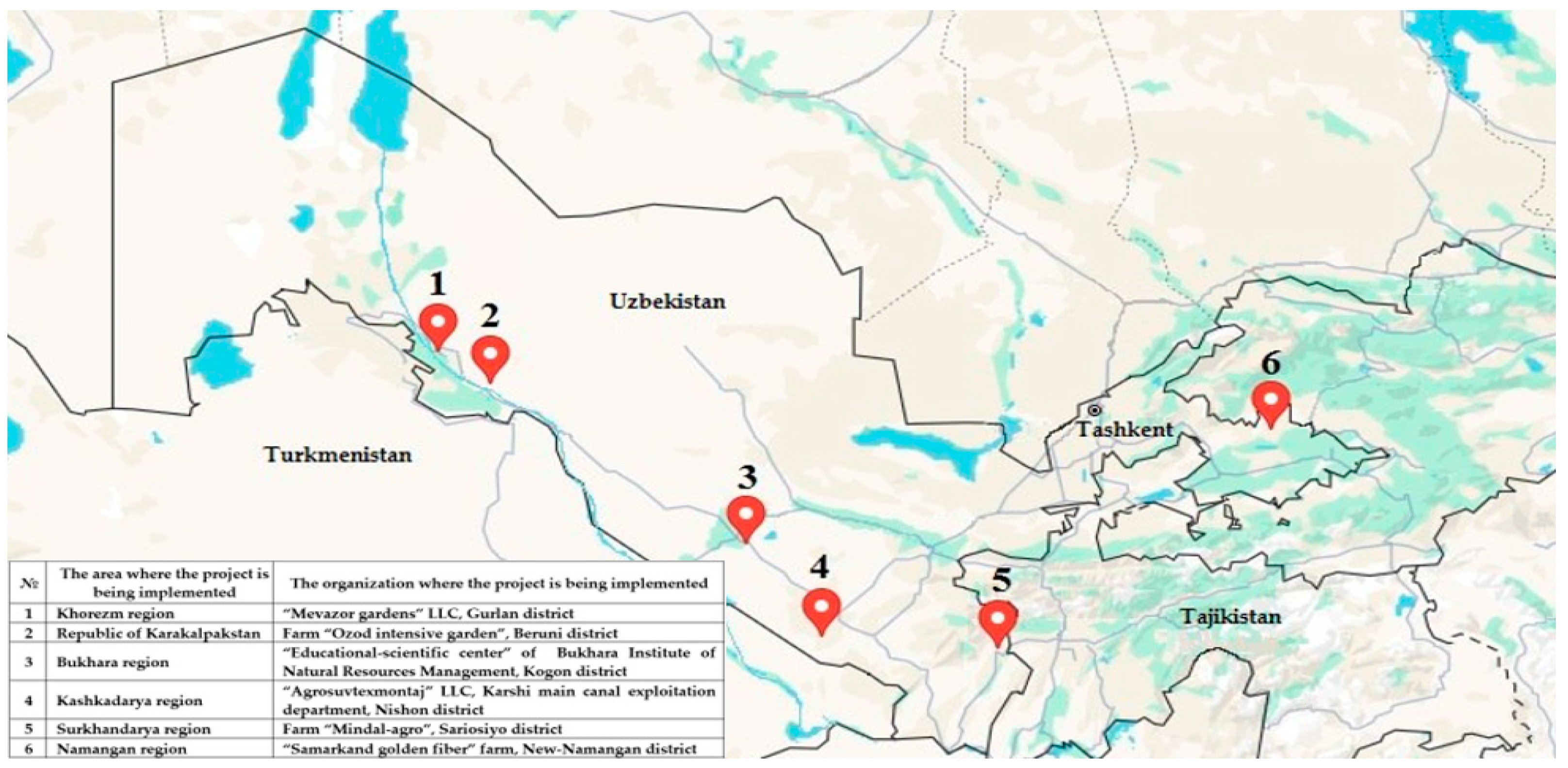

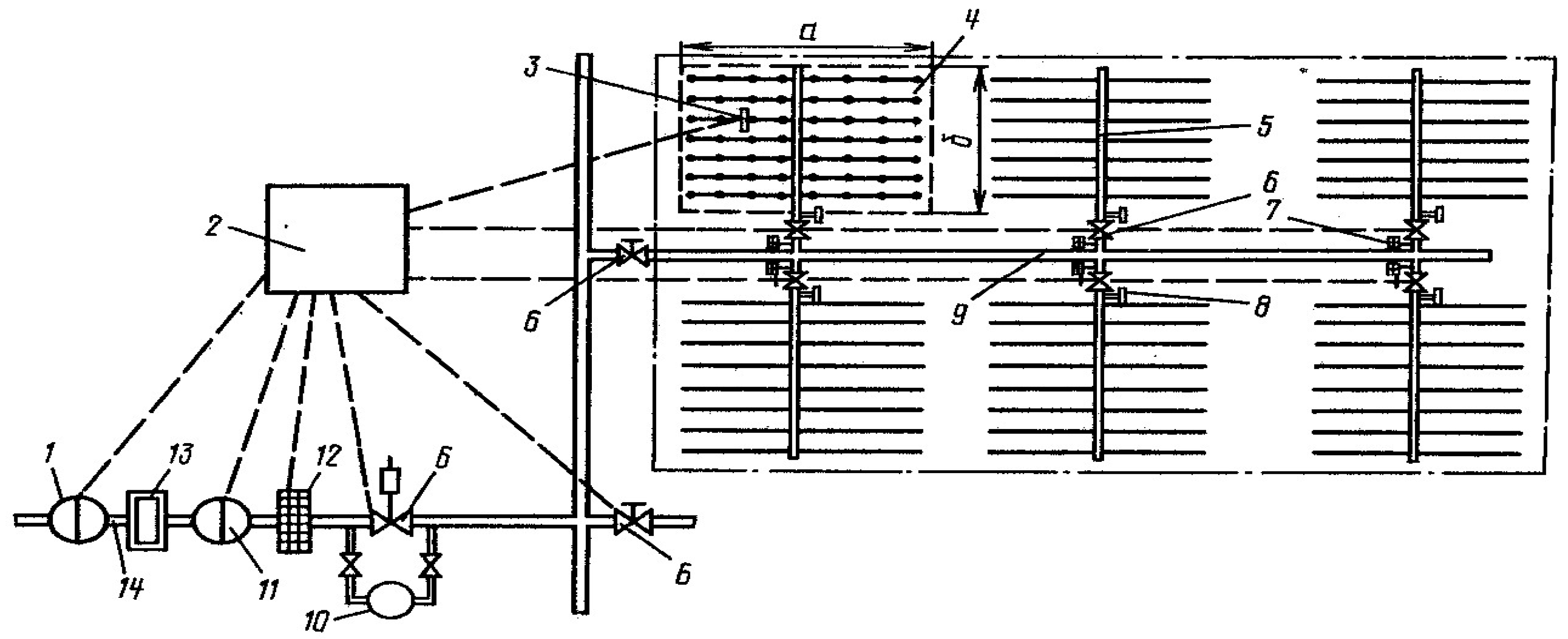
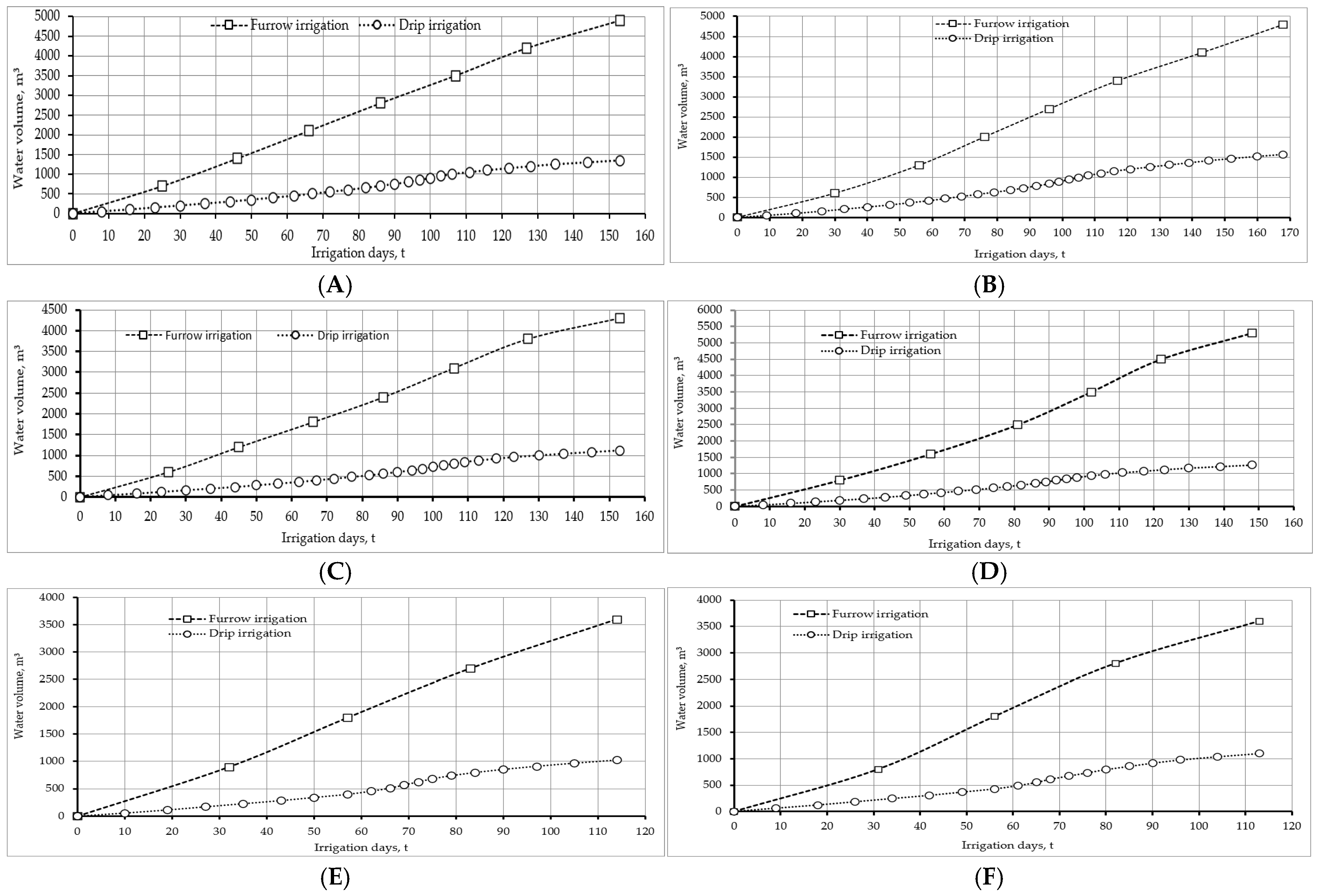

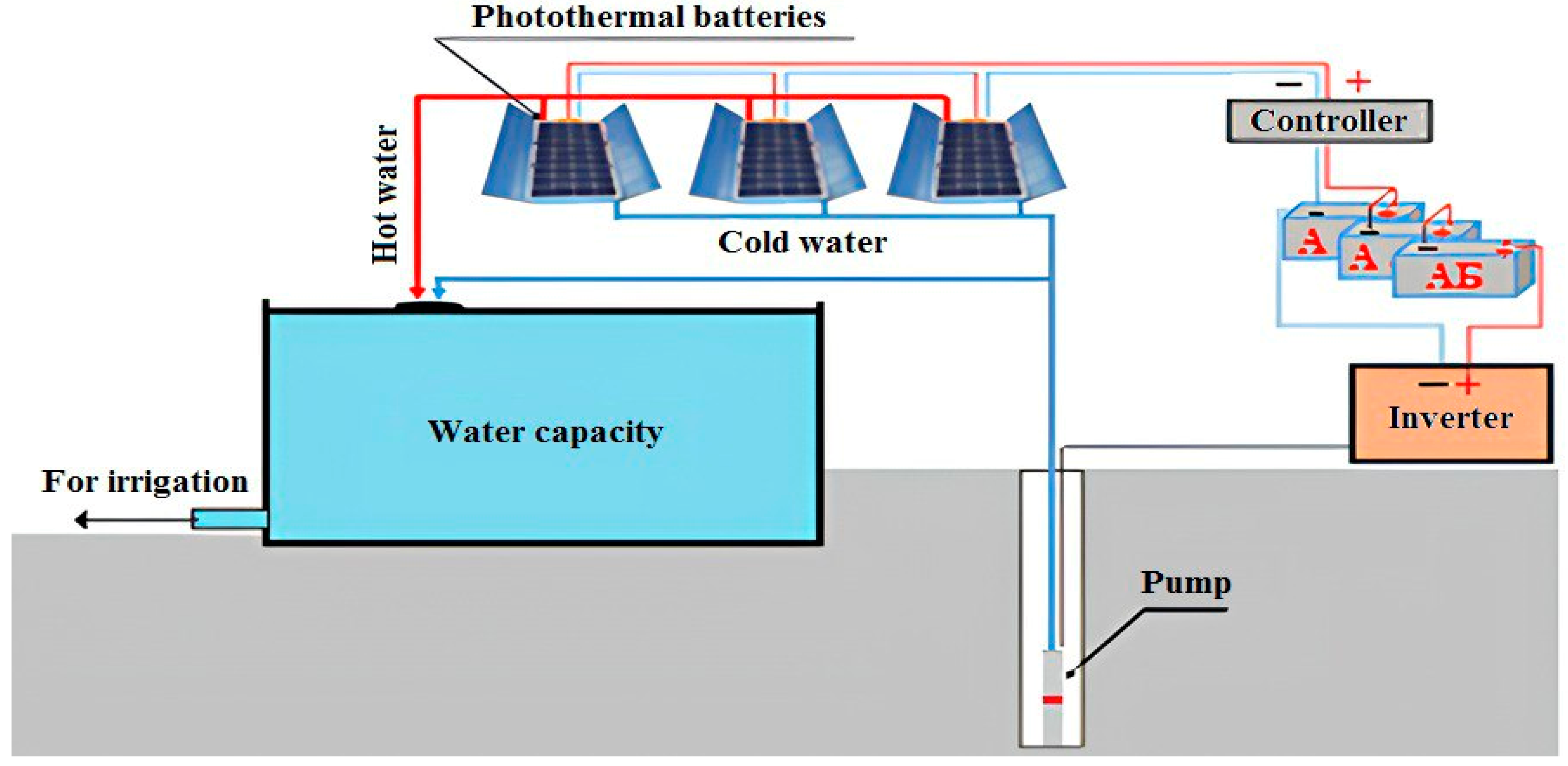
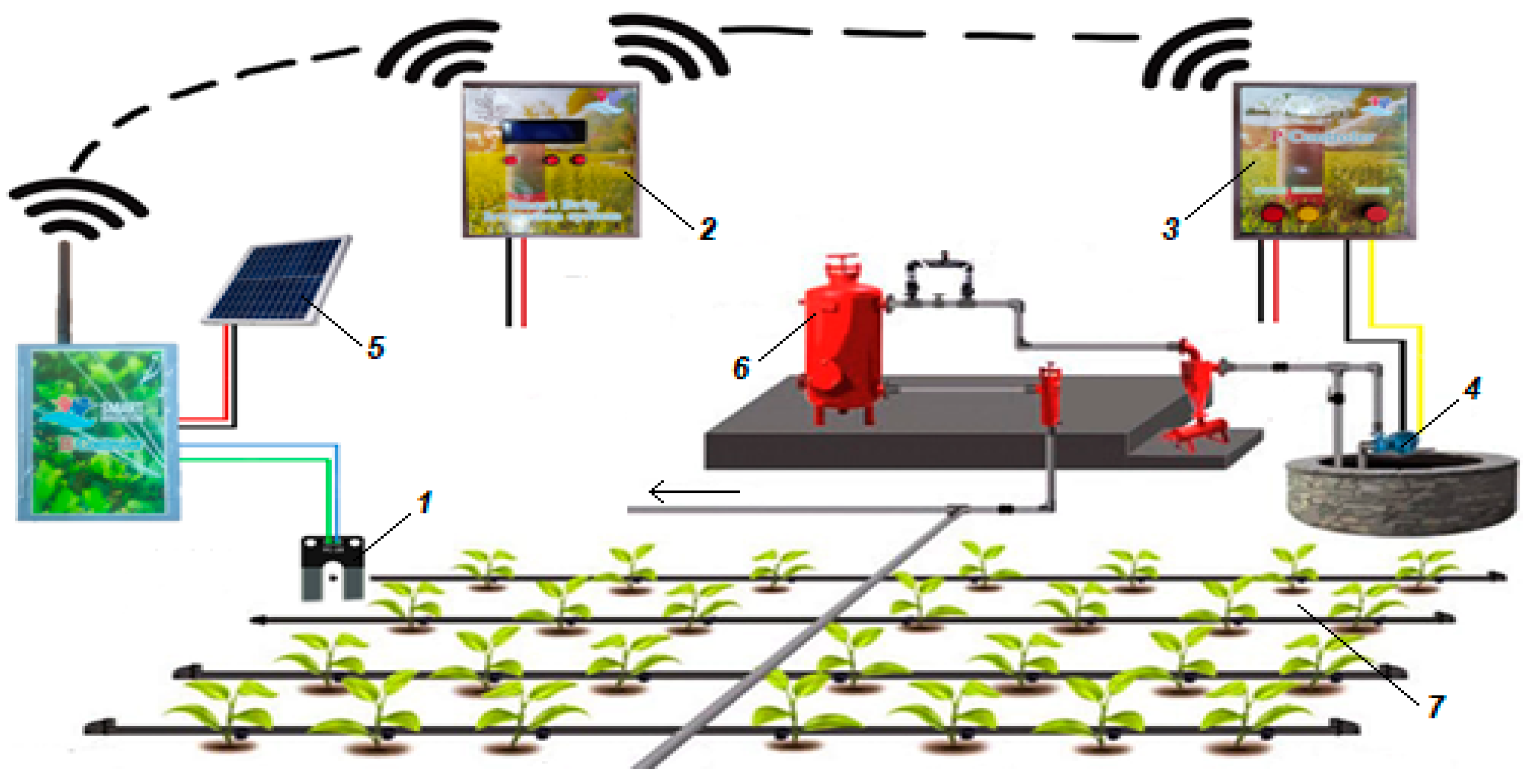



| No | The Organization Where the Project Is Being Implemented | Information About the Orchard | Types of Irrigation | Water Saved, % | ||||||||
|---|---|---|---|---|---|---|---|---|---|---|---|---|
| Mechanical, Structure of the Soil, % | Groundwater Level, m | Type of Tree | Age of Tree | Furrow Irrigation | Drip Irrigation | |||||||
| Irrigation Period/Day | Irrigation Norm, m3/ga | Age of Tree | Irrigation Period/Day | Irrigation Norm, m3/ga | Number of Irrigation | |||||||
| 1 | Republic Karakalpakstan, Beruni district “Ozod intensive bog” farm (N-I-A-b-V) | -heavy sand and clay—12.1%; -medium sandy—32.5%; -light sandy—38.0%; -sandy—17.4%. | 3.5 | apricot | 2 | 11.05–31.08/ 113 | 3600 | 4 | 11.05–31.08/ 113 | 1102 | 18 | 69.4 |
| 2 | Khorezm region, Gurlan district “Mevazor gardens” LLC (N-I-A-b-V) | -heavy sand and clay—30%; -medium sandy—47%; -light sandy—19.4%; -sandy—3.6%. | 2.5 | apple | 3 | 10.05–31.08/ 114 | 3600 | 4 | 10.05–31.08/ 114 | 1026 | 18 | 71.5 |
| 3 | Bukhara region, Kogon district, Bukhara Institute of Natural Managament “Educational and scientific center” (C-I-A-b-V) | -heavy sand and clay—18.3%; -medium sandy—30.9%; -light sandy—49.7%; -sandy—5.7%. | 2.5 | apricot, peach | 1 | 21.04–15.09/ 148 | 5300 | 6 | 21.04–15.09/ 148 | 1265 | 27 | 76.1 |
| 4 | Kashkadarya region, Koson district, “Agrosuvtexmontaj” LLC, Department of Exploitation of Karshi Main Canals (C-I-A-b-V) | -heavy sand and clay—14.3%; -medium sandy—32.5%; -light sandy—38.0%; -sandy—17.4%. | 3.0 | apricot, almond | 1 | 11.04–26.09/ 168 | 4800 | 6 | 11.04–26.09/ 168 | 1566 | 30 | 67.4 |
| 5 | Surkhandarya region, Sariosia district, “Mindal-agro” farm (C-I-A-b-V) | -heavy sand and clay—21.7%; -medium sandy—50.0%; | 5.5 | apple | 7 | 16.04–15.09/ 153 | 4900 | 7 | 16.04–15.09/ 153 | 1350 | 27 | 72.5 |
| 6 | Namangan region, New Namangan district, “Samarkand oltin tolasi” farm (C-II-A-c-IV) | -heavy sand and clay—39.0%; -medium sandy—39.7%; -light sandy—17.4%; -sandy—3.9%. | 3.5 | plum | 1 | 11.04–10.09/ 152 | 4300 | 7 | 11.04–10.09/ 152 | 1120 | 28 | 74.0 |
| The Location Where the Project Is Being Implemented | Planting Scheme | Number of Trees, pcs. | Water Supply | Water for Irrigation, м3: | Water Saving, % | ||||||
|---|---|---|---|---|---|---|---|---|---|---|---|
| Time, Hour | Number, Times | For Each Tree | Ones | During the Growing Season | |||||||
| Furrow | Drip | Furrow | Drip | Furrow | Drip | ||||||
| Karakalpakstan | 4 × 3 | 1310 | 7.5 | 4 | 18 | 0.060 | 900.0 | 61.2 | 3600 | 1102 | 69.4 |
| Khorezm | 5 × 3; 5 × 2.5 | 1020 | 7.5 | 4 | 18 | 0.060 | 900.0 | 57.0 | 3600 | 1026 | 71.5 |
| Bukhara | 6 × 5; 5 × 3 | 650 | 9.0 | 6 | 27 | 0.072 | 883.3 | 46.8 | 5300 | 1265 | 76.1 |
| Surkhandarya | 5 × 4 | 625 | 8.0 | 7 | 27 | 0.080 | 700.0 | 40.0 | 4900 | 1350 | 72.5 |
| Kashkadarya | 6 × 5; 5 × 3 | 725 | 9.0 | 6 | 27 | 0.072 | 800.0 | 52.5 | 4800 | 1566 | 67.4 |
| Namangan | 5 × 5 | 500 | 10.0 | 7 | 28 | 0.080 | 614.3 | 40.0 | 4300 | 1120 | 74.0 |
| Maximum Power PVB, Pmax | 500 W | 8 PVB |
|---|---|---|
| Coefficient of efficiency PVB, η | 20.3 % | 20.3% |
| Open circuit voltage PVB, Uoc | 22.8 B | 22.8 |
| Short-circuit current PVB, Isc | 8.9 A | 8.9 A |
| Fill factor VACh, ff | 0.71–0.73 | 0.71–0.73 |
| Thermal collector capacity (CC) made of cellular polycarbonate, V | 17 L | 17·8 = 136 L |
| Thermal conductivity of cellular polycarbonate, r | 0.2–3.9 W/m °C | 0.2–3.9 W/m °C |
| Diameters of Suspended Sediment Fractions (mm) and Their Quantity (%) | Daverage, мм | ||||||||
|---|---|---|---|---|---|---|---|---|---|
| 2.0−1.0 | 1–0.5 | 0.5–0.2 | 0.2–0.1 | 0.1–0.05 | 0.05–0.01 | 0.01–0.005 | 0.005–0.001 | >0.001 | |
| Zarafshan River (Hydropost 124, Navaiy, 10 August 2015) | |||||||||
| - | - | 20.3 | 26.3 | 27.5 | 3.4 | 2.5 | 5.5 | 14.5 | 0.133 |
| Sirdaryo River (Hydropost 1, Kal Village, 8 June 2017) | |||||||||
| - | 22.5 | 18.5 | 9.9 | 15.4 | 4.9 | 28.8 | - | - | 0.264 |
| Amudaryo River (Hydropost 83, Tuyamuyun Gorge, 29 June 2017) | |||||||||
| - | 7.5 | 16.8 | 16.9 | 22.1 | 4.6 | 1.3 | 17.4 | 13.4 | 0.161 |
| Size of Through Holes, mm | Permissible Concentration of Suspended Particles in Water and Their Sizes | |
|---|---|---|
| Concentration, g/L | Particle Size, mm | |
| <1 | 0.03–0.05 | <0.05 |
| 1–2 | 0.05–0.1 | <0.07 |
| >2 | 0.1–0.3 | <0.1 |
| Water Source and Sampling Point | Year, Day, Month of Sampling | Sediment Diameters (mm) and Their Quantity (%) | |
|---|---|---|---|
| (0.1–2.0) mm | (0.1–0.001) mm | ||
| Zarafshan River (Hydropost 124, Navaiy) | 10 August 2015 | 46.6 | 53.4 |
| Sirdarya River (Hydropost 1, Kal Village | 8 June 2017 | 50.9 | 49.1 |
| Amudarya River (Hydropost 83, Tuyamuyun Gorge | 29 June 2017 | 41.2 | 58.8 |
| No | Granulometric Composition | Hydraulic Size, mm/s | Settlement Time to a Depth of 1 m |
|---|---|---|---|
| 1 | Coarse sand (d = 1.0–0.50 mm) | 100 | 10 s |
| 2 | Medium sand (d = 0.50–0.20 mm) | 53 | 19 s |
| 3 | Fine sand (d = 0.20–0.10 mm) | 6.9 | 2.4 min |
| 4 | Sandy loam (d = 0.10–0.05 mm) | 1.7 | 9.8 min |
| 5 | Loam (d = 0.05–0.01 mm) | 0.07 | 3.9 h |
| 6 | Clay (d = 0.01–0.005 mm) | 0.08 | 2.3 days |
| 7 | Heavy clay (d = 0.005–0.00 1 mm) | 0.0007 | 16.2 days |
| 8 | Colloidal particles (d > 0.001 mm) | Hydraulic size, mm/s | 10 s |
Disclaimer/Publisher’s Note: The statements, opinions and data contained in all publications are solely those of the individual author(s) and contributor(s) and not of MDPI and/or the editor(s). MDPI and/or the editor(s) disclaim responsibility for any injury to people or property resulting from any ideas, methods, instructions or products referred to in the content. |
© 2025 by the authors. Licensee MDPI, Basel, Switzerland. This article is an open access article distributed under the terms and conditions of the Creative Commons Attribution (CC BY) license (https://creativecommons.org/licenses/by/4.0/).
Share and Cite
Majidov, T.; Bekmirzaev, G.; Ikramov, N.; Kan, E.; Berdiev, M.; Buvabekov, B.; Majidov, F. Use of Mobile Photothermic Installation on Application of Drip Irrigation Technology in Orchards of Mountain and Foothill Areas of Uzbekistan. Water 2025, 17, 872. https://doi.org/10.3390/w17060872
Majidov T, Bekmirzaev G, Ikramov N, Kan E, Berdiev M, Buvabekov B, Majidov F. Use of Mobile Photothermic Installation on Application of Drip Irrigation Technology in Orchards of Mountain and Foothill Areas of Uzbekistan. Water. 2025; 17(6):872. https://doi.org/10.3390/w17060872
Chicago/Turabian StyleMajidov, T., G. Bekmirzaev, N. Ikramov, E. Kan, M. Berdiev, B. Buvabekov, and F. Majidov. 2025. "Use of Mobile Photothermic Installation on Application of Drip Irrigation Technology in Orchards of Mountain and Foothill Areas of Uzbekistan" Water 17, no. 6: 872. https://doi.org/10.3390/w17060872
APA StyleMajidov, T., Bekmirzaev, G., Ikramov, N., Kan, E., Berdiev, M., Buvabekov, B., & Majidov, F. (2025). Use of Mobile Photothermic Installation on Application of Drip Irrigation Technology in Orchards of Mountain and Foothill Areas of Uzbekistan. Water, 17(6), 872. https://doi.org/10.3390/w17060872






